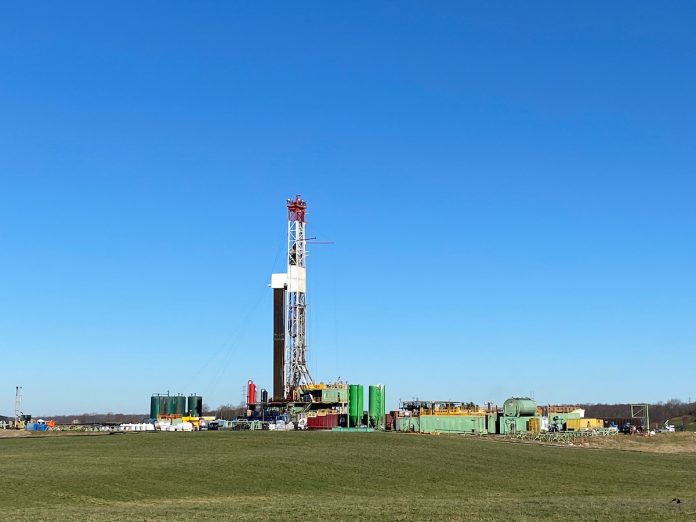By Kathiann M. Kowalski
Energy News Network
Ohio has seen a big jump in the number of agency orders forcing property owners to allow oil and gas development on their land, whether they want it or not.
The number of so-called “unitization” orders issued by the Ohio Department of Natural Resources has surged in recent years, peaking at 112 in 2022 and continuing at nearly 100 last year, according to data obtained from the agency by the Energy News Network.
The practice is common, with rules varying by state. In Ohio, lawmakers began working to streamline the process for oil and gas companies in 2019, coinciding with a decline in the state’s gas production after a seven-year fracking boom.
Those changes run contrary to other efforts in Ohio to restrict energy development in the name of neighbors’ private property rights, including strict wind farm setbacks passed in 2014 and a 2021 law allowing counties to block new wind and solar projects.
Under Ohio law, companies must meet several conditions before initiating unitization, including a showing that at least 65% of property owners in a project area consent to drilling.
Critics say the process was already tilted in the companies’ favor, and that the recent changes will make it even harder to block drilling or negotiate concessions.
“All the cards are stacked against us,” said Patrick Hunkler. In 2018, ODNR issued an unitization order for property he and his wife, Jean Backs, own in Belmont County, which is one of the state’s top-producing counties for oil and gas. The developer later canceled the project, so the order was revoked. More recently, Ascent Resources had tried to lease their land before backing out.

The legal process known as unitization has been available to Ohio oil and gas companies since 1965 but was rarely used until about a decade ago, after advances in drilling technology made it profitable to tap into harder-to-develop pockets of petroleum.
“The unitization process exists to protect the rights of those … who want to lease their minerals for development,” said Rob Brundrett, president of the Ohio Oil and Gas Association, “so that a small minority of owners … cannot stop everyone else from realizing the full potential of their property and minerals.”
For petroleum companies, the process has also promoted efficient oil and gas extraction. Otherwise, reduced pressure from too many wells could reduce the total recovery from an area.
Companies must show they have consent from owners of 65% of the area above a common oil and gas deposit before they can seek a unitization order. Companies also must show they tried to reach an agreement with holdouts, and that drilling under those properties is necessary to substantially increase the amount of oil and gas recovered. Any added value must also exceed the related costs.
“Our experience at the unitization hearing was that oil and gas runs the show,” Backs said.
Hearings don’t consider environmental impacts or other reasons landowners might not want drilling and fracking. “It’s just not part of the evaluation,” said Heidi Robertson, a Cleveland State University law professor who has written about unitization. Rather, she said, the basic question is: “Will adding this land to the unit make it easier for the developer to more efficiently and more profitably get the oil and gas out of the ground?”
The answer is almost always yes.
The Ohio Department of Natural Resources has denied only one unitization application since 2012, according to spokesperson Andy Chow. Meanwhile, it has approved more than 500 applications, with more than half the orders issued after 2020. The agency hired an additional employee in 2021 to deal with an increase in applications, Chow said.
Owners whose property is unitized won’t have pads or roads on their property, but they still get royalties and other payments. Ohio law requires “just and reasonable” compensation for landowners.
In most cases that compensation starts with a 12.5% royalty. Additional payments are adjusted for the developer’s expenses and other factors and the compensation is often smaller than that for voluntary participants. Orders typically have let companies recoup twice those amounts before unitized landowners can get payouts beyond royalties, said attorney Matthew Onest, whose firm has represented multiple landowners in oil and gas matters.
In some cases, property owners must wait even longer. At a March 27 hearing, for example, drilling company EAP Ohio asked for a “500% penalty” for owners who did not agree to a lease. Anna Biblowitz, a negotiator for Encino Energy, claimed the higher penalty was justified by the developer’s risk and “as a motivator for other working interest owners to participate.” A ruling in the case is due this month.
Why are there more orders?
Some property owners, including Backs and Hunkler, worry about climate change and other environmental impacts. They said companies wouldn’t agree to requested lease terms for no flaring, methane monitoring and monitoring of the spring on their property.
“These oil and gas companies aren’t addressing the important issues of our environment,” Hunkler said.
Other landowners may hold out because they want more money, said Onest. “They kind of dig their heels in,” he said.
Industry experts said market forces could partially explain the rise in unitization cases. Property owners could hold out more often because they want higher payments like others got early on in the state’s fracking boom. Or, higher oil prices might be motivating companies to pursue projects that once seemed too complicated to be worthwhile.
State officials have made the process easier, too. In 2019, lawmakers added language about how to calculate the 65% threshold, tucking the terms into a 2,600-page state budget law. Matt Hammond, who was then president of the Ohio Oil & Gas Association, told lawmakers the added language was meant to “clarify” the law.
In practice, the change likely lowered a barrier for companies to use the tool, according to Clif Little, an Ohio State University Extension educator in Old Washington, Ohio. “If you’re seeing actually more [cases] for forced unitization, that would be a significant player in that,” Little said.
Another law passed in 2022 requires the Ohio Department of Natural Resources to hold hearings on unitization applications within 60 days. The agency must rule within 60 days of the hearing, and also let companies know in advance if an application is incomplete.
For industry, the primary benefit from the 2022 law change was to get certainty about timing. “This impacted how a producer was able to plan their drilling schedules,” said Mike Chadsey, director of external affairs for the Ohio Oil and Gas Association.
The Ohio Department of Natural Resources also changed its guidelines last year to standardize unitization applications. The agency’s website said the changes were “aimed at streamlining the review process” and that applications would include fewer documents.
Among other things, companies don’t need to file testimony from engineers, geologists and landmen in advance of hearings — something they had generally done in the past, said Robertson at Cleveland State. In her view, that further limits any dissenting landowners’ ability to prepare challenges to such testimony when the hearing does take place.
The Covid-19 pandemic also affected unitization hearings, which are now generally held via Zoom. “Allowing these meetings to be held via Zoom is a benefit to all parties involved,” Chadsey said, adding that it’s more convenient for landowners.
Folks in “suits and ties” had to come from out of state when ODNR held the unitization hearing for Hunkler and Backs’ property back in 2017. With a remote format, though, the hearing panel and company personnel “don’t have to look at you in person,” Hunkler said.
Oil and gas companies said they take every step to avoid forced leases, but that unitization is an important tool when that is not possible.
“When those means are exhausted, which often includes situations of poor record-keeping or the inability to locate an owner, unitization can be a tool to ensure property and mineral rights are realized by all stakeholders,” said Zack Arnold, president and CEO of Infinity Natural Resources.
Jackie Stewart, vice president of external affairs for Encino Energy voiced a similar position. “Encino makes every attempt to lease all landowners in each unit and only utilized unitization after all leasing efforts are exhausted, so the property rights of Ohio’s landowners can be realized,” she said.
“This isn’t something any lawyer can handle. You have to be an expert in this stuff,” Robertson said. “And all the experts are on the other side, because that’s where the money is.”
Robertson is unaware of any legislation to make matters fairer for landowners who don’t want to lease their land. And gerrymandering makes it unlikely such bills will be passed anytime soon. As she sees it, the process is “stacked against the dissenting landowner.”
(This article first appeared on Energy News Network and is republished here under a Creative Commons license.)











This is a big step forward for landowners in Ohio. Unitization orders force property owners to let oil and gas drilling on their land, frequently against their will, which is why the current spike in these orders is troubling. 2019 saw a streamlining of the procedure, which appears to favor oil and gas firms and make it more difficult for landowners to bargain or stop drilling. Critics point out issues with the environment and property rights, while supporters contend that it encourages effective extraction and benefits consenting owners. It’s critical to continue learning about and participating in this ongoing topic.